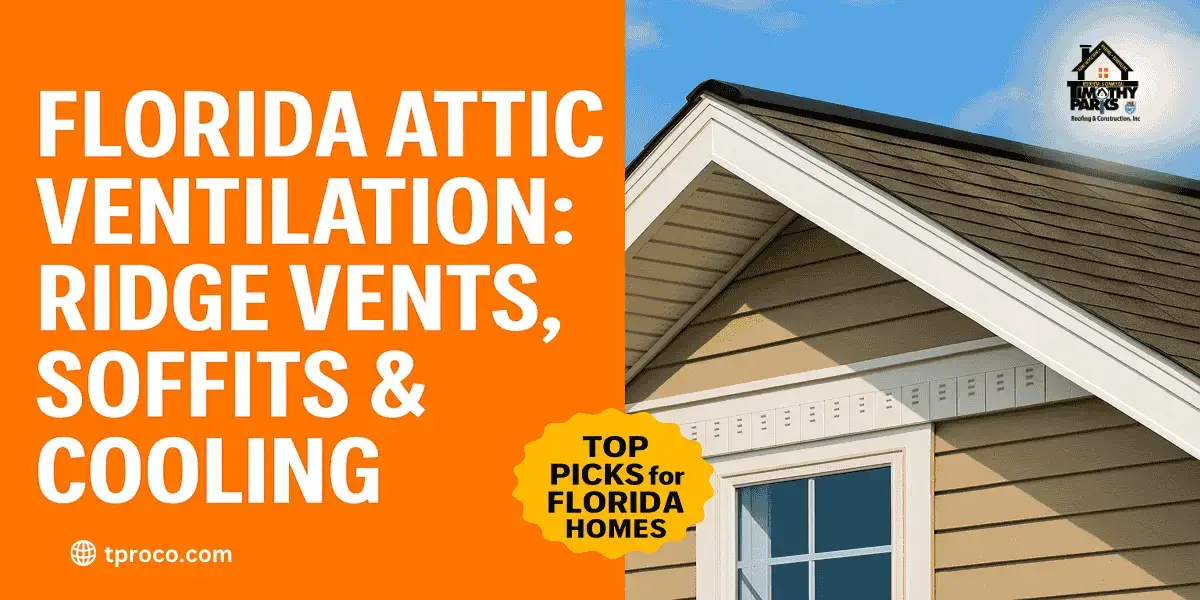Our Blogs
Florida Attic Ventilation: Ridge Vents, Soffits & a Cooler Roof 🌬️
In Florida, your attic can skyrocket to 130°F+, straining your AC and warping roof materials from below. A well-planned ventilation system—using ridge vents, soffit vents, or even solar fans—can release trapped heat, dryness, and moisture, making your roof last longer. But how do you ensure proper airflow without letting in driving rain or losing energy? This blog breaks down attic ventilation fundamentals for Florida’s environment, from choosing continuous ridge vents to verifying your soffits aren’t blocked by insulation. By optimizing airflow, you reduce thermal stress, curb mold growth in humidity, and keep your AC from working overtime. Let’s unlock a cooler, healthier attic and a more durable roof in Florida’s climate.

1. Why Attic Ventilation Matters in Florida’s Heat & Humidity
Florida’s climate puts unique stress on unventilated or under-ventilated attics:
- Excessive Heat Buildup: Asphalt shingles or metal roofs can heat up drastically under midday sun, pushing attic temps so high they radiate into living spaces. This forces your AC to run longer, spiking energy bills.
- Moisture & Mold Risk: Florida’s air often carries high humidity. If that moist air seeps into the attic and can’t escape, condensation can form on rafters or decking, leading to mold or rot.
- Roof Material Degradation: Heat from below accelerates shingle cracking or underside membrane stress. Proper airflow can reduce peak temperatures and slow age-related wear.
- Insulation Effectiveness: Overly hot or damp attics degrade insulation performance. Fiberglass or cellulose might clump or sustain mold, losing R-value.
Hence, installing or upgrading attic vents is one of the best defenses against Florida’s punishing heat. Ventilation helps flush out superheated air, reduce moisture buildup, and maintain a stable environment for both your roofing system and the insulation that keeps your home comfortable.
2. The Soffit-to-Ridge Vent System Explained
In Florida, one common approach is a continuous soffit-to-ridge system, ensuring balanced intake (soffits) and exhaust (ridge):
Soffit Vents (Intake):
- Positioned along the eaves’ underside, letting cooler outside air flow into the attic’s lower portion. Vented soffits must be unobstructed by insulation.
- In Florida, aluminum or vinyl perforated soffits resist rust in humid, coastal conditions. Combined with baffles, they prevent insulation from blocking vents.
Ridge Vent (Exhaust):
- Runs along the roof’s peak, letting hot attic air escape via natural convection. Warm air rises, pulling in cooler air from soffits in a continuous cycle.
- Some Florida ridge vents use baffles or weather filters to block wind-driven rain or insects. If installed incorrectly (like a short vent or zero baffle), storms can push water inside.
When balanced properly, the attic sees a steady airflow from eaves to ridge, carrying away heat and moisture. This passive system relies on temperature and pressure differentials—no electricity or fans needed. However, you must ensure enough net free vent area—1:150 or 1:300 ratio of vent area to attic floor space, depending on Florida code and any vapor barrier presence. If your attic is large or subdivided, additional vent solutions may be needed.
3. Adding Powered Attic Fans or Solar Ventilators
Some Florida homeowners boost airflow with powered fans or solar attic vents:
- Electric Attic Fans: Thermostatically or humid statically controlled fans that kick in at a certain attic temperature/humidity. They forcibly expel hot air, reducing the attic’s peak temps.
- Solar-Powered Attic Fans: Use built-in solar panels to run the fan motor, no external wiring. Great for areas with consistent sun—like Florida. Can reduce electric bills slightly by removing heat load.
- Hybrid Approaches: Some folks keep the passive ridge vent system but add a powered fan near the gable or roof slope for extra help on scorching days.
While fans can speed up heat removal, Florida building experts debate if they risk drawing conditioned air from living spaces if your attic isn’t sealed well. Ensure your attic floor is sealed to avoid negative pressure sucking AC-cooled air out. Also, a poorly installed or leaky fan might allow water intrusion in storms. Used correctly, though, a solar or electric fan can shave attic temps, especially in big or complex roof designs that hamper natural convection.
4. Common Ventilation Mistakes in Florida
Attic ventilation fails if poorly designed or maintained:
Blocked Soffits with Insulation:
Over time, insulation can shift and cover soffit vents. No intake means your ridge vent or fan can’t pull in fresh air, nullifying the system.
Insufficient Exhaust or Intake Balance:
You might have a big ridge vent but minimal soffit vents, or vice versa. Florida code prescribes a balanced approach to achieve effective air exchange.
Mixing Ridge Vent with Gable Fans:
Combining different exhaust systems can short-circuit airflow if not carefully planned. For instance, a gable fan might pull air from the ridge vent instead of soffits, bypassing the attic floor.
Venting into Attic:
Bath or kitchen exhaust fans dumping moist air into the attic fosters mold. In Florida, that moisture-laden air must vent outside.
Choosing a single, well-executed intake and exhaust strategy typically outperforms random additions. Start by verifying your soffits are open and unobstructed, then ensure your ridge or fan exhaust is suitably sized for Florida’s climate. A licensed Florida roofer or building specialist can perform a vent calculation to see if your attic meets code or if you need additional vents or fans.
5. Maintenance & Checking Performance
Once you have a ventilation system, keep it functioning optimally:
- Regularly Clear Debris: Florida storms can blow leaves or debris into soffit openings. Inspect eaves for blockages and remove them.
- Inspect Ridge Vents for Warping or Loose Caps: The intense sun can warp plastic vent covers. High winds may dislodge nails or screws. Repair promptly to avoid water infiltration.
- Check Attic Humidity & Temperature: A quick glance at an attic thermometer or humidity gauge can reveal if your system is effectively flushing out heat/moisture.
- Fan Testing: If using an electric or solar attic fan, test its on/off function occasionally. Florida’s humidity might corrode wires or thermostatic controls over time.
- Seal Attic Bypasses: Even with good vents, if can lights, plumbing stacks, or wiring holes let AC air leak into the attic, you’ll have inefficiency. Sealing these gaps complements your ventilation plan.
Florida’s environment is dynamic—small changes in your vent system or blockages can degrade performance. By scheduling an annual or biannual check (like part of your roof inspection), you ensure everything remains open and in good shape. This effort pays off in a cooler attic, healthier roof decking, and fewer mold concerns.
Conclusion
In Florida’s scorching, muggy climate, attic ventilation is a must for a cooler home, lower AC bills, and a roof that endures storms without warping or mold. Whether you install continuous soffit-to-ridge vents, a powered attic fan, or a solar alternative, the goal is consistent airflow: bringing fresh air in at the eaves and exhausting heated air near the peak. Avoid pitfalls like blocked soffits, mismatched vent systems, or underestimating humidity infiltration. And if you’re uncertain about code requirements or balancing intake and exhaust, consult a Florida roofer who can do the math and ensure your vents meet wind-uplift standards. With a well-ventilated attic, your roof not only lasts longer—it also keeps your living spaces more comfortable under the Sunshine State’s blazing heat.
Frequently Asked Questions (FAQ)
🌬️ Florida Attic Feeling Like an Oven? Time to Vent It Right!
Trapped heat and humidity can destroy your roof and spike your AC bill. Discover the power of ridge vents, soffits, and solar fans to keep your attic cool, dry, and Florida code-compliant.
#tproco #tppro #tprci #urro #rrfl
#AtticVentilation #FloridaHeat #RidgeSoffitVents #TampaCooling #OrlandoRoofTips #SunshineState
Schedule a Free InspectionAbout the Author

Timothy Parks
CEO
📢 Stay Informed: Communication & Consent Updates
At Timothy Parks Roofing & Construction Inc., we prioritize transparency in our communications. By submitting a request, you agree to receive calls, texts, and emails regarding our services. Standard messaging rates may apply. You can opt-out at any time by replying STOP or contacting us directly.
✅ Florida License: #CBCO59592, #CCC1327217, #HI4878
📌 Privacy & Terms: Read our Privacy Policy and Terms of Service.



